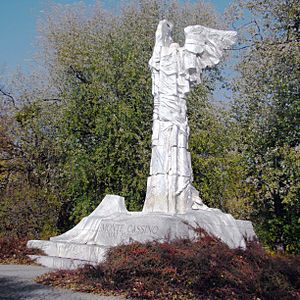Monument to the Battle of Monte Cassino, Warsaw facts for kids
| Pomnik Bitwy o Monte Cassino w Warszawie | |

The monument to the Battle of Monte Cassino
|
|
| Coordinates | 52°14′49.6″N 21°00′01.18″E / 52.247111°N 21.0003278°E |
|---|---|
| Location | The square between General Anders Street and the gates of the Krasiński Gardens |
| Designer | Kazimierz Gustaw Zemła (sculpture), Wojciech Zabłocki (architect) |
| Material | Reinforced concrete covered with white marble |
| Height | 12 meters |
| Opening date | May 30, 1999 |
| Dedicated to | The Battle of Monte Cassino |
The Monument to the Battle of Monte Cassino is a special memorial in Warsaw, Poland. It stands in a square between General Anders Street and the beautiful Krasiński Gardens. This monument reminds everyone of the brave Polish soldiers who fought in the Battle of Monte Cassino during World War II.
Contents
Building the Monument
This monument was built to honor the Polish soldiers who fought in a very important battle. In December 1994, a group called the Social Committee chose the perfect spot for it. This committee was formed to help build the monument.
Design Competition
In June 1995, the Association of Polish Architects held a contest. They asked designers to create a plan for the monument. This was to remember Poland's part in the Battle of Monte Cassino.
Funding the Project
The money to build the monument came from many places. Veterans, who are former soldiers, gave money. These veterans were part of the Polish Army 2nd Corps. This group of soldiers captured Monte Cassino on May 18, 1944. Many other groups and organizations also gave money to help.
Unveiling Ceremony
The monument was officially shown to the public on May 30, 1999. Irena Anders helped to unveil it. She was the wife of General Władysław Anders, who led the 2nd Corps. The Polish Army had an honor guard there. This is a group of soldiers who stand to show respect. The ceremony also marked 55 years since the battle. A representative for the President of Poland was also there.
Monument Details
The monument was designed by a sculptor named Kazimierz Gustaw Zemła. An architect named Wojciech Zabłocki also helped.
Materials and Size
The monument is made of very strong reinforced concrete. This concrete is covered with beautiful white Carrara marble. It is very heavy, weighing 220 tonnes. To make sure the tallest part, a 12-meter column, stood firm, deep holes were dug. These holes were six meters deep.
Main Sculpture
The main part of the statue is a 12-meter tall column. It looks like a headless Nike, who was a goddess of victory. The statue shows signs of fighting and injury. This reminds us of the tough battle.
Base of the Monument
At the bottom of the monument, you can see several important symbols. There is a shape that looks like the hill of Monte Cassino. It is covered with a shroud, which is a cloth used to wrap something. You can also see a figure of the Virgin Mary. Scattered helmets are also part of the design.
Engravings and Symbols
The base of the monument is two meters tall. It has special carvings on it. You can see the Monte Cassino Commemorative Cross. This is a special award for those who fought in the battle. There are also symbols of the five Polish army units that fought there. A Polish eagle, which is Poland's national symbol, is also carved. Inside the base, there is an urn. This urn holds the ashes of the brave heroes.
Smaller Memorials
Next to the main monument, there are two smaller memorials. One has a plaque with a picture of General Władysław Anders. The second is a "monument of gratitude." It thanks the people of Persia, which is now Iran. They kindly welcomed over 120,000 Polish refugees in 1942. These refugees were escaping from the Soviet Union with the Anders Army.
Gallery














